Wok Cooking 101

In my last blog, I mentioned how during these months of lockdowns (self-imposed and otherwise), I’ve spent a lot of time experimenting with recipes. Several of them have been inspired by the fact of not being able to eat out at some of my favorite restaurants and being relegated to only carry-out.
For some reason during this pandemic, I developed huge cravings for Asian dishes, including Chinese, Thai, Vietnamese, Korean and South Asian (mostly Indian) dishes. These are the cuisines that I love and enjoyed on a regular basis at my favorite local spots, but those same dishes delivered to my home lost a lot in the transportation. So, I decided to create my own. And in the process, I realized that my kitchen wasn’t entirely set up to prepare most Asian cuisines.
I corrected this by making sure that my kitchen was stocked with most of the ingredients necessary to accomplish this: various types of Asian rice (Thai jasmine rice, sushi rice, basmati rice), mirin, sake, rice wine vinegar, toasted sesame oil, peanut oil, fish sauce, toasted sesame seeds, tamarind paste, coconut milk, Thai curry pastes, as well as other kitchen staples like onions, scallions, cilantro, ginger, garlic and veggies of all kinds. But my absolute new favorite ingredients are Sichuan peppercorns and Chinese black vinegar. Ten years ago, these items would have been impossible to find but thankfully they aren't now.
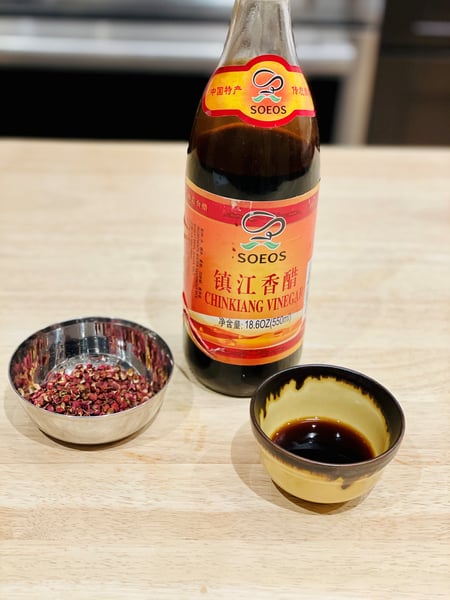
The one piece of equipment that was missing from my kitchen was a well-seasoned wok! Purchasing a wok can be a very personal thing. It’s something that you should feel very comfortable with using and something easy to maintain, something that is right for the size of kitchen and the type of stove top that you have. It took me weeks of research before I finally decided on the brand and type that I purchased. And I’m absolutely thrilled with my purchase.
A great wok for home cooking doesn’t need to be expensive. You can find a good wok that will last for years and some can even be purchased for under $40.
For those who aren’t sure what a wok is or why it’s necessary, a wok is traditionally a round-bottomed, high walled pan, but the new flat-bottomed versions are becoming increasingly popular and gaining in popularity over traditional woks because they can be used on most standard range tops. Most are commonly designed with either two side handles or one long handle.
One of the benefits of using a wok over a traditional frying pan is that it distributes heat a lot more evenly. This is due to its concave shape with sloping sides, as well as the material that the wok is made out of. With better heat distribution you get less hot or cold spots, thereby ensuring that everything in the wok has finished cooking at the same time. Also because of its shape, tossing and stir-frying food is a lot simpler, allowing ingredients to fall back into the wok with every toss.
A wok is most commonly used for stir-frying, but because of its unique design, it has several other potential uses as well. Since it’s so deep, it can be filled with water and used to boil foods, or filled with oil for deep frying. If it comes with a lid, the wok can also be used for steaming vegetables or seafood.
It’s important that you use the correct oil for wok cooking. When choosing an oil, you should always select one with a high-smoke point. These are oils that can withstand a high temperature (around 400° Fahrenheit) before they begin to smoke. If you use an oil with a low smoke point, you risk burning your oil and tainting the flavor of the entire dish.
Types of Oil to Use in Wok Cooking
Peanut Oil: Peanut oil has a nutty subtle peanut flavor which is the perfect flavor for many wok dishes, (especially dishes that are Chinese in origin). It has a smoke-point of 450° F. It does spoil and turn rancid faster than other oils. So, it’s best to buy in small quantities unless you’re going to be doing a lot of Thai or Chinese cooking within a few months’ time.
Vegetable or Canola Oil: Inexpensive with a neutral flavor. These are good all-around oils that will work for most wok cooking. Both will maintain a temperature of 400° F, they will also last a long time in your pantry and can also be used in a lot of baking applications as well as high heat cooking.
Avocado Oil: Like avocados, it has lots of monounsaturated fats, and can be used at temperatures up to 500°F, so it’s great for stir frying and has a fresh mild flavor.
Grapeseed Oil: A great second choice as an all-purpose cooking oil. It can be used at temperatures up to 400° F, and the flavor is neutral, clean and fresh, which makes it the perfect oil to use for most anything that you’re cooking.
While researching my wok of choice, I had to also consider the material of the wok. There’s carbon steel, which is the most popular material. It combines fast and even heating with durability, making it a favorite. With proper seasoning, a carbon steel wok can easily reduce the chance of food sticking to the pan. A stainless-steel wok is a very durable choice, that also gives a very professional appearance. It’s a lot less porous than cast iron or carbon steel, so it is not as vital to season for optimal performance. It is also easier to clean, as it has a naturally smooth surface. Lastly there’s cast iron, which is extremely durable and capable of holding onto heat much longer than the other cookware materials mentioned. Once it’s hot, it stays hot for a long period of time saving on energy. The longer it is used the more seasoned it becomes, making it more nonstick as it ages, instead of losing non-stick properties. However, one of its’ drawbacks is its’ weight. I ended up choosing a wok made out of carbon steel.
As with all carbon steel pans, the first order of business is seasoning the pan. A well-seasoned carbon steel wok will become increasingly more non-stick the more you use it. To maintain the seasoning, (natural nonstick surface), of a wok, keep the surface very dry and lightly oiled between uses. After cooking immediately wash and dry the wok. Drizzle a small amount of oil into the wok and use a paper towel or dish towel to rub the oil over the carbon steel surface.
Over time, a carbon steel wok will turn from shiny silver, to lightly brown, to a beautiful matte shade of black. A dark black surface is an indication of a well-seasoned wok.
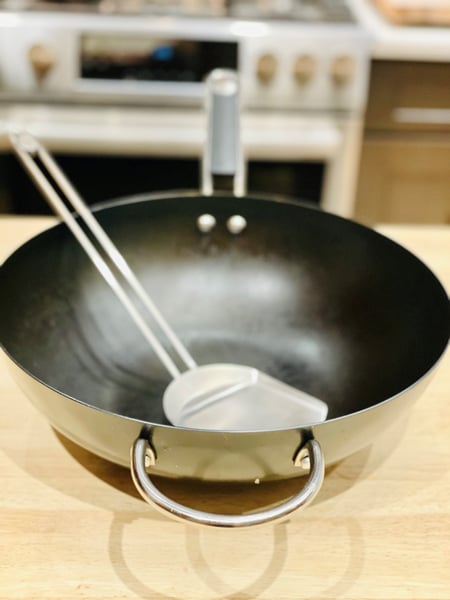
The wok I purchased, was a Kuhn Rikon, 5Qt wok skillet with lid. It is the wok that is highly recommended by Christopher Kimball from Milk Street. The instructions before using suggested washing the wok inside and out in hot soapy water, then dry over low heat on your stovetop.
In order to season the pan, Christopher Kimball suggests placing the wok over high heat until a drop of water evaporates on contact. Next, add 2 tablespoons of neutral oil that can maintain a high temperature, swirl the oil in the pan over medium heat until the interior surface is coated. Add in sliced or chopped onions, ginger or scallions and cook. As they start to soften, spread the mixture over the entire surface of the wok’s interior. Continue doing this for about 20 minutes over medium heat, adding oil if the ingredients become too dry or start to burn. Discard the mixture, allow the wok to cool down completely, then rinse with hot water and a soft sponge to remove excess food particles. Heat the wok on low heat until completely dry. Coat lightly with vegetable oil and wipe clean with a paper towel before storing. In time the seasoning process will change the color of the wok’s interior, this is called a patina and will darken with each use. Once seasoned, soap is not recommended for cleaning as it will negatively affect the patina and require re-seasoning.
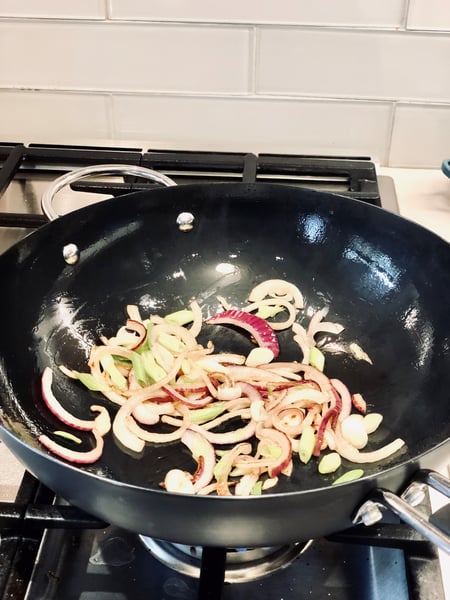
I’ve gotten so much use out of this wok these past few months. At least once a week, I look forward to pulling it out and creating an Asian inspired dish around its use. My favorite dishes to prepare so far have included, Mongolian Beef, Shrimp Pad Thai, Orange Chicken, Penang Curry with Shrimp, and Keema Aloo, (South Asian style Ground Beef). But by far my absolute favorite is Kung Pao Chicken.
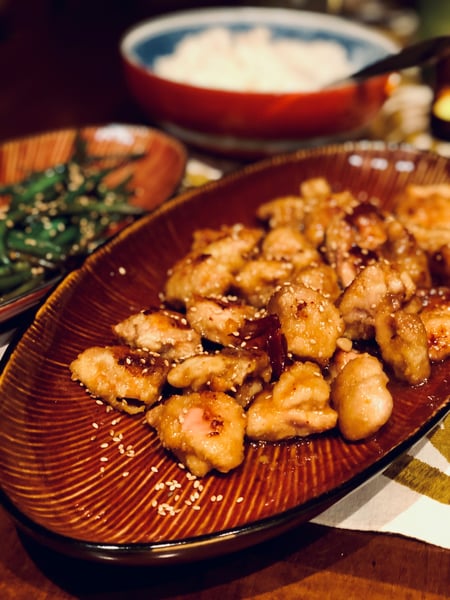
Orange Chicken
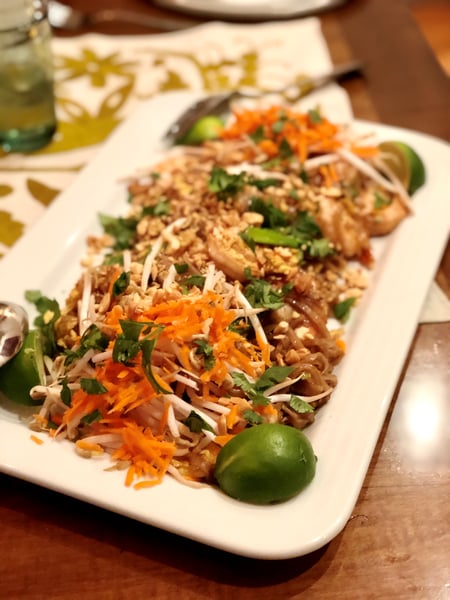
Shrimp Pad Thai
Kung Pao Chicken is my favorite number one dish because of its simplicity. Secondly, most of the ingredients are already on hand in your refrigerator and pantry. But mostly, it’s because of the incredible Chinese ingredient Sichuan peppercorns. Sichuan peppercorns aren’t really a pepper at all. Sichuan peppercorns are the pinkish-red dried outer husks of the prickly ash shrub.
Sichuan peppercorns have an aromatic fragrance, similar to lavender. It’s main claim to fame is the powerful numbing sensation it causes around the mouth. When married together with chili peppers, (the other key ingredient in Sichuan cuisine), Chinese chefs believe this numbing effect reduces the chili pepper’s heat, leaving diners free to appreciate its intense fruity flavor. For me, there is nothing cooler than eating a bite of a dish containing Sichuan peppercorns and then drinking something cool afterwards. Food scientist Harold McGee likens the sensation to a mild electrical shock: “touching the terminals of a nine-volt battery to the tongue.” Harold McGee also says the sensation of eating Sichuan peppercorns is actually kind of invigorating, it’s like eating Pop Rocks in the mouth! I just love the sensation, but I absolutely love the flavor of them. But if you’re not ready or are having difficulty finding them, a good substitute for Sichuan peppercorns is to use freshly ground black pepper and coriander seeds. The combination of both provides the same flavors that Sichuan peppercorns would.
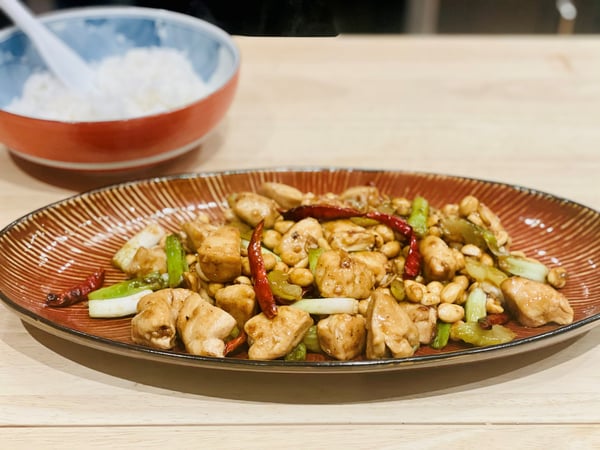
Kung Pao Chicken
For the marinade:
12 oz chicken breast, cut into 3/4” cubes
1 teaspoon vegetable/canola oil
1 teaspoon cornstarch
1 teaspoon Shaoxing wine or Japanese sake, or dry sherry
1/4 teaspoon sea salt or kosher salt
1/8 teaspoon of ground white pepper
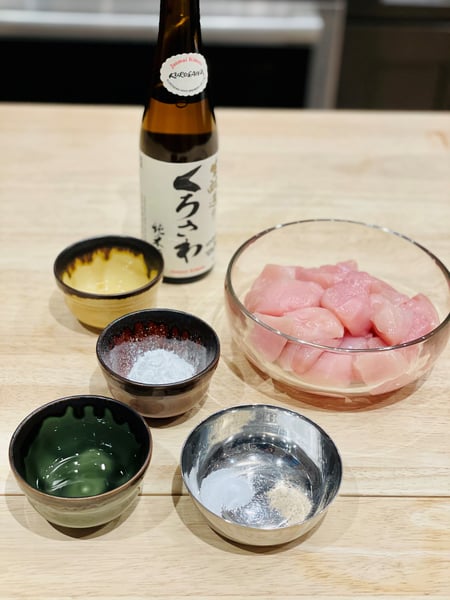
For the sauce:
1 tablespoon light soy sauce
1 teaspoon dark soy sauce
1 tablespoon rice wine vinegar
1 teaspoon sugar
3 tablespoons water
1 teaspoon cornstarch
1 tablespoon Chinese black vinegar or balsamic vinegar
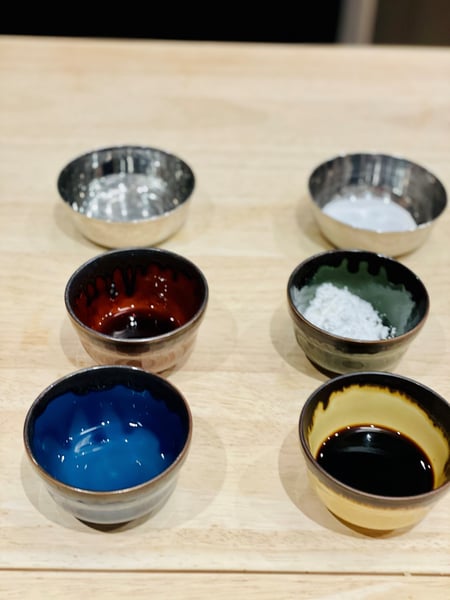
3 tablespoons vegetable/canola oil divided, 1 to be used later
4 cloves garlic, smashed and thinly sliced
3 thin slices of ginger, minced or 1 teaspoon grated
10 dried red chilies, (stems and seeds removed)
1/2 teaspoon of ground Sichuan peppercorns (I use a spice grinder)
1/2 cup of roasted unsalted peanuts
2 stalks of celery sliced on the bias
6 scallions, white portions only, cut into 3/4” pieces
1 teaspoon of toasted sesame oil to drizzle at the end after cooking
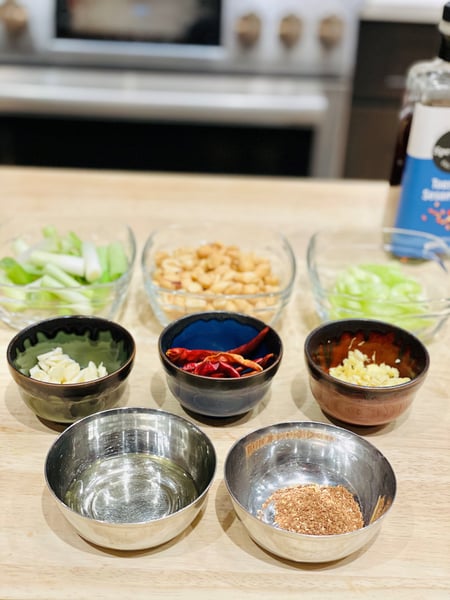
1. Mix together the chicken with all the marinade ingredients in a bowl and set aside for 20 minutes.
2. Mix together all the sauce ingredients in a medium bowl and set aside.
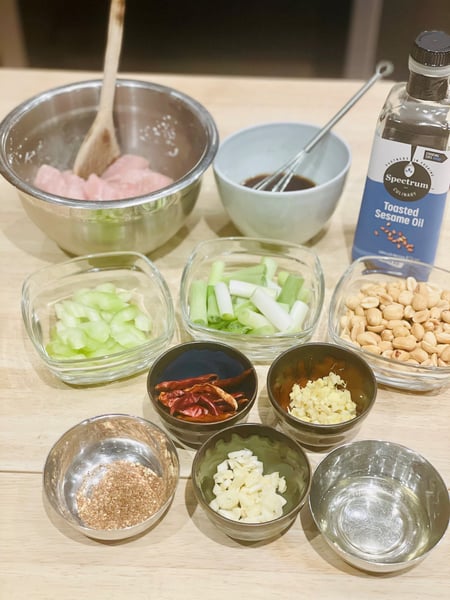
3. After the chicken has marinated, heat 2 tablespoons oil in a wok over high heat, swirl the oil in the wok. Sear the chicken until it begins to brown, about 2-3 minutes, remove from the wok to a bowl, and set aside.
4. Turn the heat to low and add the other tablespoon of oil. Add the ginger, chilies, garlic, ground Sichuan peppercorns, scallions, and celery. Cook for a minute of two until fragrant.
5. Add the chicken back to the pan and turn the heat up to high. Stir-fry for a minute and then use your finger or a small spoon to stir up the sauce ingredients (the cornstarch will have settled to the bottom, so make sure it’s well incorporated). Add the sauce to the wok and stir-fry for another minute until the sauce thickens, which will happen pretty quickly.
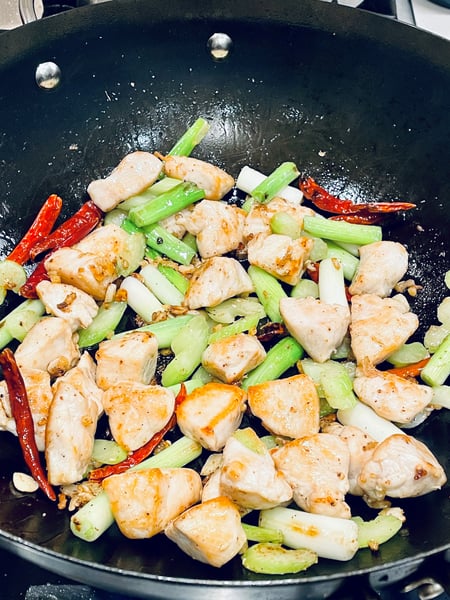
6. Finally add the peanuts and stir. To finish drizzle with the teaspoon of toasted sesame oil and serve.
7. Serve alongside with some steamed rice.
The Chopping Block has several Asian-themed virtual classes coming up in January. Learn techniques for this type of cooking in:
- Virtual Sushi Night Saturday, January 9
- Virtual Ramen Workshop Saturday, January 30 3pm
- Virtual Dim Sum Sunday, January 31 11am CST
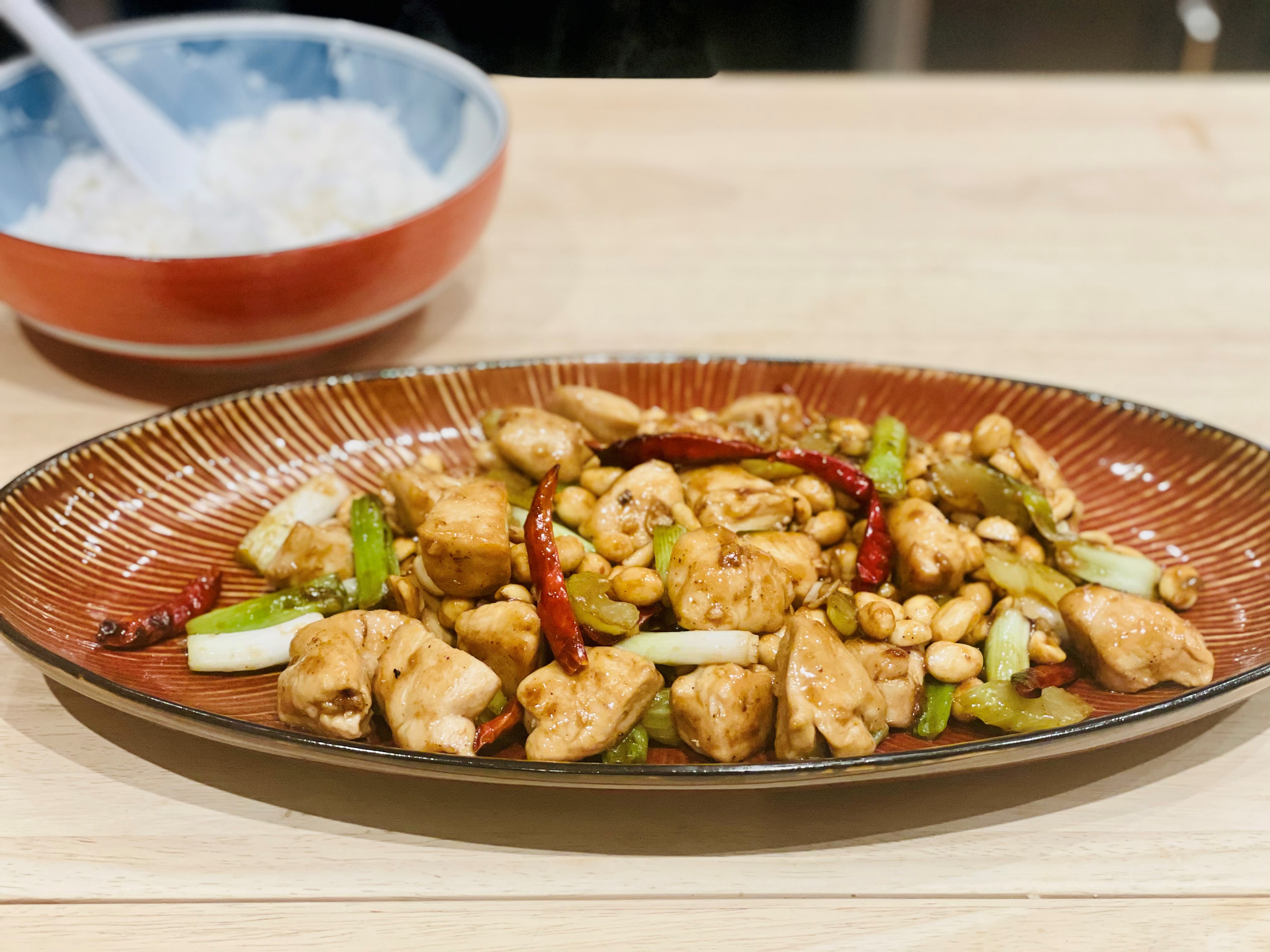
Kung Pao Chicken
Ingredients
- 12 oz chicken breast, cut into 3/4” cubes
- 1 teaspoon vegetable/canola oil
- 1 teaspoon cornstarch
- 1 teaspoon Shaoxing wine or Japanese sake, or dry sherry
- 1/4 teaspoon sea salt or kosher salt
- 1/8 teaspoon of ground white pepper
- 1 tablespoon light soy sauce
- 1 teaspoon dark soy sauce
- 1 tablespoon rice wine vinegar
- 1 teaspoon sugar
- 3 tablespoons water
- 1 teaspoon cornstarch
- 1 tablespoon Chinese black vinegar or balsamic vinegar
- 3 tablespoons vegetable/canola oil divided, 1 to be used later
- 4 cloves garlic, smashed and thinly sliced
- 3 thin slices of ginger, minced or 1 teaspoon grated
- 10 dried red chilies, (stems and seeds removed)
- 1/2 teaspoon of ground Sichuan peppercorns (I use a spice grinder)
- 1/2 cup of roasted unsalted peanuts
- 2 stalks of celery sliced on the bias
- 6 scallions, white portions only, cut into 3/4” pieces
- 1 teaspoon of toasted sesame oil to drizzle at the end after cooking
Instructions
- Mix together the chicken with all the marinade ingredients in a bowl and set aside for 20 minutes.
- Mix together all the sauce ingredients in a medium bowl and set aside.
- After the chicken has marinated, heat 2 tablespoons oil in a wok over high heat, swirl the oil in the wok. Sear the chicken until it begins to brown, about 2-3 minutes, remove from the wok to a bowl, and set aside.
- Turn the heat to low and add the other tablespoon of oil. Add the ginger, chilies, garlic, ground Sichuan peppercorns, scallions, and celery. Cook for a minute of two until fragrant.
- Add the chicken back to the pan and turn the heat up to high. Stir-fry for a minute and then use your finger or a small spoon to stir up the sauce ingredients (the cornstarch will have settled to the bottom, so make sure it’s well incorporated). Add the sauce to the wok and stir-fry for another minute until the sauce thickens, which will happen pretty quickly.
- Finally add the peanuts and stir. To finish drizzle with the teaspoon of toasted sesame oil and serve.
- Serve alongside with some steamed rice.

